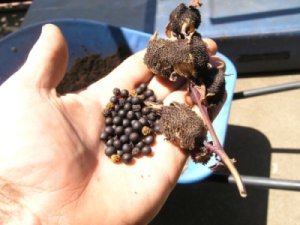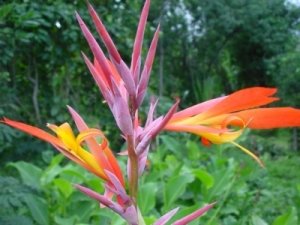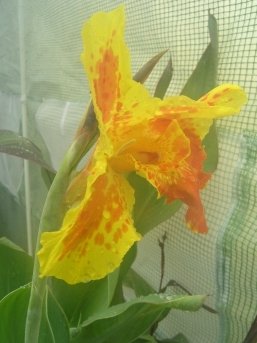





Whether as Canna Lilies, Indian Shot, Queensland Arrowroot or just plain Cannas, most gardeners are familar with species of the Cannaceae genus or Canna family. They are a very popular ornamental with a practically endless range of showy hybrids, a long history as a source of beads for jewelry-makers & a lesser known potential as an important food crop. Love them or hate them, they are hardy & versatile plants with an interesting history & a big future.
(Editor's Note: This article was originally published on February 28, 2008. Your comments are welcome, but please be aware that authors of previously published articles may not be able to promptly respond to new questions or comments.)Canaceae belongs to the Zingiberales order which also includes such familiar plants as plantains (commonly thought of as bananas), heliconias, strelitzias, the gingers and true arrowroot. The entire genus - consisting of around 27 species - hails from the Carribean, where cannas commonly grow along roadsides amongst bananas and taro. They are a perennial herb growing from 1 to 2 metres, depending on the species. Most commonly seen are ornamental hybrids (C. indica x generalis) featuring fluorescence ranging in colour from white, through yellow, pink and orange to red, visiting every imaginable hue & parti-colour en route. Similarly, there is a wide range of colour amongst canna foliage stretching from pale green to almost black, including a number of variegated varieties. The majority of these named cultivars are sterile in the sense that they do not produce seed, but are able to propogate themselves through the spread of branching rhizomes.
One of the tallest growing cannas - C. indica - flowers only red & is rarely chosen as an ornamental. This species was named by the famous botanist Carolus Linnaeus, under the mistaken impression that it originated in India. It has at least two historical synonyms, C. coccinea and C. lambertii. [1] As the mother of most hybrids it is an important species for breeders. Whilst cannas can be propagated by division of rhizomes, the production of seed and any new hybrid depends upon the availability of such a fertile strain.

One of C. indica's common names - Indian Shot - is derived from the fact that its seed is hard & spherical, much like the pellets fired from antique firearms such as muskets. There is no clear recorded use of the seed in this way, but it is certainly a possibility. Modern tests have shown that C. indica seeds fired from a 12-gauge shotgun will penetrate quarter inch plywood at close range. [1] Speculation aside, these same characteristics have seen the seed employed as one of the world's most popular natural beads for hundreds of years (home jewelry-makers, take note) [1][2][3]. In India for example, the seeds are traditionally harvested green and bored out before being left to harden. They are also used by Catholics who have a long tradition of drying flowers to make rosaries.[3] Similarly, these seeds are sometimes used to make musical instruments such as shakers.

Another canna species that has been intensively cultivated is C. edulis (syn. C. discolor), Achira or Queensland Arrowroot. C. edulis is one of the world's only two sources of arrowroot. Demand for this valuable starch has seen C. edulis grown as a crop in Queensland, Australia on a large scale. As a result, most Australians are familar with the taste of canna via arrowroot biscuits though this does little to illustrate the culinary importance of this starch or the potential of C. edulis as a major food crop of the future. Arrowroot is easily digested meaning it is ideal for children and convalescents, as well those afflicted with gluten intolerance. It is the highest quality thickener available for the production of sauces and gravies, plus a far superior substitute for gelatin in the making of crystal clear jellies & silky smooth ice cream. Loved by the British for over 100 years and grown large-scale in Australia and the West Indies, its is believed to have inspired Napoleon to once claim that England's love of arrowroot was born of a need to support its colonies.[1]

Importantly, C. edulis is a reliable, easily propagated crop that can be harvested twice annually. This fact combined with the high quality starch it produces means it has been singled-out by groups seeking solutions to present and future world hunger.[4] Whilst it has many, this potential to feed millions is easily the most notable aspect of the amazing canna family.
The latest chapter of our long romance with this plant is its use as one of the most varied and hardy of all ornamentals. Hybrid cannas are possibly the most consistent garden feature in the English speaking world and beyond. An uncountable array of ornamental cultivars have been bred over the last hundred or so years, many being re-invented & renamed several times over. Whether its the Italian hybrids you go for, Australian Zodiacs or America's eye-catching Tropicanas, there is a canna somewhere for everyone. It is the type of plant that one can love, become too familar with and through some new discovery of its amazing versatility and hardiness, learn to love all over again.
Ingredients (serves 6)
Preheat oven: 200°C. On a sheet of baking paper, draw a circle 20 - 30cm in diameter. Place face down on a baking tray. Dust with 1 teaspoon arrowroot flour.
In a large bowl, beat eggwhites & cream of tartar until soft peaks form. Gradually add sugar (saving 1 tablespoon), beating constantly until thick. Add remaining arrowroot flour & sugar. Fold through vanilla & vinegar to form a meringue.
Spoon meringue onto baking paper & using the pencil mark, shape it into a circle with a depressed centre. Reduce oven to 100°C. Bake for approximately 80 minutes or until dry & crisp. Turn off oven, open door & leave to cool. Don't worry if it sinks. Whilst it is cooling, slice strawberries & skinned kiwi fruit.
Slide baked meringue onto a serving plate. Spread with cream & top strawberries, kiwi fruit & passionfruit pulp. Dust with icing sugar if desired. Enjoy.
Copyright © www.100flowers.win Botanic Garden All Rights Reserved